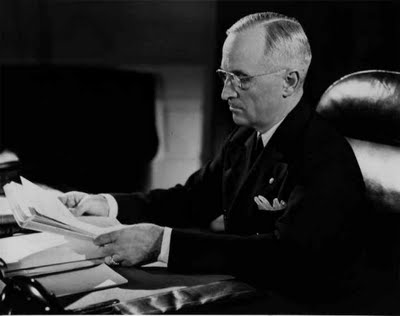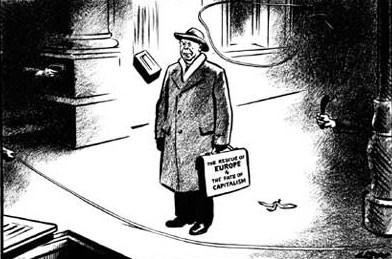Democrat - July-August 2010
Route to the European Constitution
3. Quest for a United
States of Europe
Role of the USA, CIA and Winston Churchill
3. Quest for a United States of Europe
Role of the USA, CIA and Winston ChurchillIn 1942 Winston Churchill circulated a paper to the war cabinet
proposing there be a European Council to establish a United States
of Europe after the end of WWII. This proposal was put by British
officials in the talks held by the then Allies in the anti-Hitler
coalition. The USSR objected stating "certain projects for
a federation reminding the Soviet people of the policy of a cordon
sanitaire that is widely known to have been directed against the
Soviet Union, and which is accordingly viewed negatively..."
The Soviet government considered it "premature , both from
the point of view of the interests of small countries themselves
and of the general European postwar settlement to artificially encourage
the unification of any states into federations". (1)
After the end of WWII in 1945 and the ravages of that war on the
continent of Europe a landslide election result in Britain swept
a Labour government into office and tipped Churchill out. Churchill
had been a successful popular wartime leader. In 1946 Churchill
delivered a speech evangelising European unity in the form of a
federalist United States of Europe (USE). However, Churchill was
adamant this was for mainland Europe and not for Britain which retained
imperialist interests in the Commonwealth of former colonies and
dominions. This is the source of confusion and why both some of
those opposed to and for the European Union try and claim Churchill
for themselves but it is clear he was all for a USE but without
Britain.

Winston Churchill addressing European Conference 1 March 1949. Duncan Sandys is on the right
In 1947 the Truman 'doctrine' was declared as "the policy of
the United States to support free peoples who are resisting attempted
subjugation by armed minorities or by outside pressures." (2)
This doctrine became a main plank for US foreign policy and was
recognised as the start of the 'cold war' with the USSR and to prevent
countries taking the alternative to capitalism namely a socialist
economy. Churchill publicly endorsed this doctrine. J Foster Dulles
who had apparently been a Nazi sympathiser(3) and was now Secretary
of State when Eisenhower was President. Dulles voiced US ruling
circle aims for the creation of an "economic and political
association" of Western Europe in which West Germany would
be involved to replace the "structure of independent unassociated
sovereign ties".

US President Truman with his 'Doctrine' for US foreign policy
Shortly after the Truman doctrine the European Recovery Programme
(ERP) or Marshall Plan was announced by this US Secretary of State
whereby funds would be passed to west and southern European nation-states
and Turkey. This was the practical economic side of the doctrine
to prop up capitalism and fend off socialist aspirations and was
supported by Britain but opposed by the USSR. The money flowed for
three years from 1948 to 1951 and totalled at the time to $12.5
billion.
At the same time the military aspect of the doctrine was advanced
in the form of a political association which became NATO. As well
as economic advisers the US sent military advisers to countries
"threatened by communism" which included Greece and Turkey.

Ambivilant
cartoon by David Lowe on the Marshall Plan.
The briefcase
says "The rescue of Europe and the fate of capitalism" (Evening Standard 1.1.48)
Whilst negotiations were being conducted to put in place the European
Defence Community (EDC) (see part 2 of this series) other parallel
talks and proposals were on the table to set up a European Political
Community. The six States in the European Coal and Steel Community
gave the task of drawing up a Treaty for EPC to the ECSC's Assembly.
A Constitutional sub-committee was formed to draft a federalist
constitution which included a two chamber parliament with a directly
elected lower house and a European Senate with nationally appointed
delegates. The plan included a Court of Justice and an Economic
and Social Committee.
In these negotiations the Dutch Government proposed there should
be a common market amongst the six States. This aspect was not followed
through as it was opposed by some nation-states which wanted to
retain tariffs and quotas on trade. In the background and largely
out of sight was the rivalry between different imperialist interests
including those of the USA.
The unofficial ad hoc European Movement was formalised out of several
national movements in 1948 and came out in favour of this draft
EPC treaty. Winston Churchill was one of four Presidents of Honour
and his son-in-law Duncan Sandys was President. If any proof were
needed that USA foreign policy was for some form of a 'United States
of Europe' it is the money amounting to $millions funnelled into
the European Movement and European Youth Campaign by an American
Committee for a United Europe (ACUE). The vice chairman of this
committee was Allen Dulles, head of the CIA. The funds came from
the Rockefeller and Ford Foundations.(4)
Allen Dulles CIA chief
The European Movement didn't have political power but was a well-funded
propaganda machine to advocate a USE in western and southern Europe.
A previous advocate of a 'United Europe', Napoleon, always sent
in the scribes before the troops and occupation!
In parallel to talks about a common market and an EPC were discussions
in the Council of Europe about a European Agricultural Community.
This foundered for several reasons including a veto by Britain which
had at the time trading partners in agricultural products with former
colonies and dominions of the British Empire now called the "Commonwealth".
Two proposals for a European transport authority were launched in
1950. The outcome was the formation of the European Conference of
Ministers of Transport (ECMT) with an HQ in Paris in 1953. The reluctance
of States to give up sovereignty over this key aspect of economic
life led to the ECMT turning into a talking shop.
The draft treaty for EPC was adopted unanimously by the ECSC Assembly
and put before the relevant Foreign Ministers. Negotiations gradually
stalled because of differences between States over who should have
power and whether or not the EDC should be ratified all round first.
The coup de grace to EPC was delivered in 1954 by the deputies in
the French Assembly who threw out the European Defence Community
project.
However, the federalists pursued their goal along several tracks.
The main method used was to set up an unofficial sub-committee of
the European Movement - an Action Committee for a United States
of Europe in 1955. Two sectors were picked out to go alongside the
ECSC - nuclear energy and a common market for trade. This was the
period when Egypt nationalised and then blocking the Suez Canal,
and intervention of the USSR in Hungary in 1956. The US government
opposed the military invasion into Egypt by Israel, Britain and
France to reclaim the Canal. This foreign policy declaration made
clear the USA dominated militarily the capitalist world at that
time.

US President Eisenhower and Secretary of State J Foster Dulles
American foreign policy in this period, largely initiated by J
Foster Dulles, was to set up similar blocs to NATO (1949-) under
its control and included CENTO(1955-1979) in the Middle East, SEATO
(1954-1977) in South East Asia and ANZUS (1951-) which involves
the USA, Australia and New Zealand. This policy was nicknamed 'pactomania'.
These blocs like NATO and the embryo Common Market had both military,
economic and trade aspects.
-----
1 Vsevolod Kniazhinsky : West European Integration:
Its policies and International relations
2 Reference on line
3 Karlheinz Deschner: The Moloch - (Dulles ascribed assets of $1
billion to the Nazi party in 1933 after Hitler's election and publicly
supported Hitler)
4 Richard J. Aldrich: OSS, CIA and European unity: The American
committee on United Europe, 1948-60
See other pieces in this series:
Part 1 Paris Treaty - European Coal and Steel Community
Part 2 European Defence Community and Western European Union
See also Political device (the ECSC) folded into European Union - 2002
New treaty - European Stability Mechanism - 2011